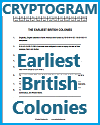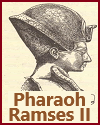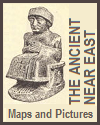| Ancient Egyptian Hieroglyphics |
| www.studenthandouts.com > World History > Ancient Egypt > Ancient Egypt Maps and Pictures |
 |
|
Egyptian Hieroglyphic Writing from the Rosetta Stone: The writing is from right to left. The few words here shown mean "Raising a statue of the king of Egypt, Ptolemy eternal beloved of Ptah." The Latin alphabet, used to write the English and other languages today, is descended from ancient Egyptian hieroglyphics. Click here to enlarge this image.
Ancient Egyptian hieroglyphic writing developed over thousands of years and went through several stages of evolution. Pre-Dynastic Period: The earliest form of Egyptian writing was pictorial. People in ancient Egypt used simple images or pictograms to represent objects and ideas. These early symbols were the precursors of hieroglyphs. Early Hieroglyphs: By around 3000 BCE, during the Early Dynastic Period, hieroglyphs had evolved into a more sophisticated writing system. Hieroglyphs began to represent both concrete and abstract concepts, and some symbols took on phonetic values. Old Kingdom: During the Old Kingdom period (circa 2686-2181 BCE), hieroglyphic writing continued to develop. Scribes refined the system and used it extensively in monumental inscriptions, such as those found in tombs and on pyramids. Middle Kingdom: Hieroglyphic writing became more standardized during the Middle Kingdom (circa 2055-1650 BCE). Scribes began to create lists of hieroglyphs and developed grammatical rules for their use. Hieratic Script: Alongside hieroglyphs, the ancient Egyptians also developed a cursive script called hieratic. Hieratic was more practical for everyday writing, as it was quicker to produce and didn't require detailed pictorial representation. It was often used for administrative and business documents. Demotic Script: The later periods of ancient Egypt saw the development of the demotic script (circa 7th century BCE), which was even more simplified and cursive than hieratic. It was used for various types of writing, including literature, legal texts, and administrative documents. Rosetta Stone: The decipherment of hieroglyphs was greatly aided by the discovery of the Rosetta Stone in 1799. This stone inscription contained the same text in hieroglyphs, demotic, and ancient Greek, allowing scholars to work out the hieroglyphic script's meaning by comparing it to the known Greek text. Champollion's Breakthrough: French scholar Jean-François Champollion is credited with deciphering hieroglyphs in the 1820s. He made the significant breakthrough of realizing that some hieroglyphs represented sounds (phonetic values), while others were logograms (representing whole words or concepts). Hieroglyphs remained in use for religious and monumental inscriptions in Egypt for many centuries, but as the culture evolved and the use of the Egyptian language declined, the writing system gradually fell out of everyday use. However, the study of hieroglyphs has continued, and they remain an essential part of understanding ancient Egyptian history and culture. |
 |
 |
 |
 |
 |
 |
|---|
| Ancient Egypt Books and Films | Ancient Egypt Outlines and PowerPoints |
| Ancient Egypt Maps and Pictures | Ancient Egypt Study Games |
| Ancient Egypt Miscellany | Ancient Egypt Worksheets |
| www.studenthandouts.com > World History > Ancient Egypt > Ancient Egypt Maps and Pictures |






